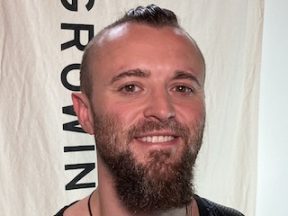In 2013 David Lindahl opened a sort-of public service Twitter account. Its purpose was to alert folks in his native Washington State when Mt. Rainier was visible, unobscured by clouds. He called the account Rainier Watch, as in keeping watch on that dominant landmark.
Fast forward to 2023, and Rainier Watch is a community, a website, and a manufacturer of mountain-themed apparel. The business is a side hustle to Lindahl’s day job as a web developer. But it may soon require full-time focus. Sales have increased dramatically, owing in part to in-person markets and local REI stores.
Lindahl and I recently spoke. We discussed the company’s origin, launching the apparel component, and the benefits of in-person selling. The entire audio of our conversation is embedded below. The transcript is condensed and edited for clarity.
Eric Bandholz: Give us a rundown of what you do.
David Lindahl: I run a small apparel company called Rainier Watch, inspired by Mount Rainier in Washington State. It started in 2013 as an online community, and it’s grown into an apparel brand, which I launched several years ago. I design and sell apparel and donate a portion of each sale to the national parks. I’m also a photographer, web developer, and a dad.
It started with me tweeting. Mount Rainier is this cool landmark here in Washington, and you can see it hundreds of miles away. However, it rains a lot, so the mountain’s not always visible. “The mountain is out” is a local phrase. So in 2013 I started tweeting on my way to work when the mountain was out, which only happens 50 to 75 days a year. It all snowballed from there. I hadn’t used Twitter before that.
I launched the apparel component in 2018 with no background in ecommerce, design, or websites. I’ve learned a lot and still haven’t scratched the surface of everything related to direct-to-consumer ecommerce. We’re a niche and geo-specific brand, and I’ve started to expand beyond Mount Rainier. I have stickers and hats coming soon for the other national parks here in Washington.
I do my own fulfillment. It’s been a small-scale operation — 200 monthly orders, more or less. This year has been different as we’ve grown, but we don’t have so many orders requiring us to outsource. We ship to all 50 states. It’s pretty cool to see all the mountain lovers nationwide. I try to add a personal touch to each shipment. I have customized packaging and packing tape, and I used to handwrite notes and draw mountains on the back of cards.
Bandholz: How do you maintain the passion for a side project?
Lindahl: It drives me. For years, I’ve gotten up at 4:35 a.m. before my day job. Most mornings, I work on the business, designing apparel and thinking of making beanies and hats. I enjoy it a lot. We’ve had astronomical growth this year, like a thousand percentage points, so that’s been cool. I love creating things and having a beanie I can hold as something I made or passed to a designer to finish.
Focus can be difficult. I have often fallen into the squirrel syndrome of chasing shiny objects. There are a slew of fun things to work on. I try to focus on a high return on investment and low effort, but I still struggle. It’s not easy, but I limit my to-do list. Making paper notes helps. I plan my week bullet style in a journal.
We’ve had a banger year. I’m not sure I can identify a single point that has led to the growth. Getting into REI several months ago has been huge. I’ve gone from zero stores to seven in less than six months. I’m in REI’s buy-local program. Our wholesale business went from zero to $10,000 a month. And D2C sales have nearly doubled. We’ve gone from 100 orders a month to, again, 200 or more.
Bandholz: You are doing in-person markets.
Lindahl: Yes. It’s been a good sales channel this year. I hired someone to run them for me a few months ago. He’s been fantastic. He’s been running upwards of five a month. It’s a work in progress — learning which markets are good and which aren’t, especially as they relate to our customers and the weather. In-person markets spike in the summer and around Christmas time. Many variables go into it — some markets bomb.
It’s a ton of work with much trial and error. This is the first year that I’ve outsourced the staffing. I hope we are somewhat profitable and it benefits him and me. At the end of the year, I see it as marketing. We’re getting our name out there.
A large percentage of folks prefer in-person shopping. Having a booth and REI presence are legitimizers. I often get emails or direct messages asking where someone can find our products. The website’s open 24 hours a day, but consumers want to touch, feel, and see things in person.
Finding the right markets is a process. There’s a lot of them in the area. We don’t have real winter here. There’s no snow. So markets run throughout the year. We talk to other vendors and learn which ones are good and which aren’t. The booth fees vary a lot. Sometimes it’s a night market and costs only $100 to enter. Other times, it’s a multi-day event for around $700.
It’s good to be there explaining the brand. Most people haven’t heard of us. I have my guy there telling our story and describing our products. I don’t see it as a huge profit center. It’s more exposing our name and hopefully turning a profit at the end of the year.
Bandholz: Where can listeners support you?
Lindahl: The website is RainierWatch.com. I’m @austriker27 on Twitter.




